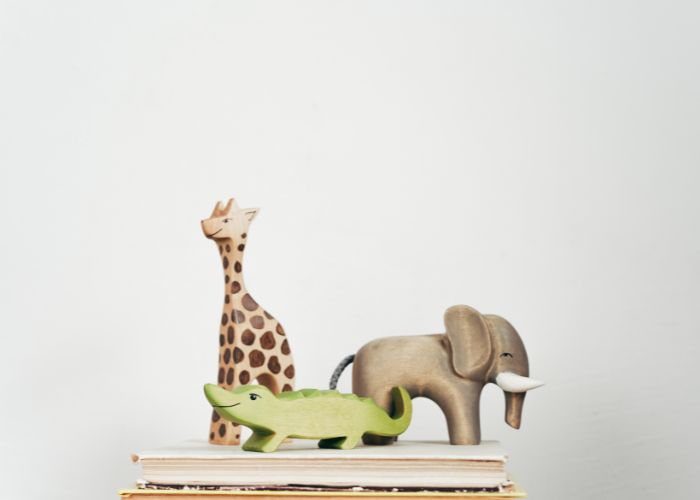In this post, we will talk about the beauty and benefits of minimalist toys, highlighting how they can influence creativity, sustainability, and a more mindful approach to children’s education.
Minimalist toys offer a more mindful alternative to today’s overvalued consumerism, reminding us of the importance of slowing down, simplifying, and valuing the present moment. Instead of opting for toys filled with lights and sounds, parents are increasingly seeking alternatives that nurture imagination and encourage children’s cognitive development.
Minimalist toys are proving to be a smarter choice for both parents and children, as they stimulate creativity and help foster a more conscious mindset towards consumption.
What Are Minimalist Toys?
Minimalist toys stand out for their simplicity, elegance, and functionality, representing a lighter and more mindful approach to children’s entertainment. In contrast to conventional toys, often characterized by an excess of stimuli like lights and sounds, these toys emphasize essence over excess, promoting a deeper and more meaningful play experience.
Simplicity is the “cornerstone” of minimalist toys, as they are designed to be simple and free of unnecessary elements, allowing children to explore and imagine freely without sensory overload. These toys stimulate creativity and autonomy, empowering children to develop their own narratives and solutions to challenges they encounter during play.
Besides their simplicity, minimalist toys also stand out for their durability and quality. They are usually made from natural materials like wood or organic fabrics and are built to withstand the test of time, offering years of fun without the need for constant replacement.
This durability not only provides more cost savings but also reduces waste and promotes a more sustainable consumption mindset, aligned with environmental concerns.
Benefits of Minimalist Toys

Stimulating Creativity
Minimalist toys are drivers of children’s creativity because instead of offering pre-determined functionalities, these toys encourage children to explore their own ideas and imagination. With their simplicity and versatility, minimalist toys allow little ones to create entire worlds in their minds, developing rich narratives as they play.
Children have the opportunity to take on the roles of creators and inventors, exercising essential cognitive skills for their development while having fun.
Developing Concentration
The simplicity of minimalist toys also plays a crucial role in developing children’s concentration. In a world full of distractions, these toys offer a distraction-free environment, allowing kids to engage in activities or play for longer periods. By focusing on a single task or play activity, children learn to concentrate their attention, developing important skills for adulthood.
Promoting Sustainability
Concern for sustainability is one of the main features of minimalist toys. Made almost always from natural materials like wood or organic cotton, these toys are a conscious choice for parents concerned about the environmental impact of their purchases.
Moreover, the durability of these toys means they can be passed down from generation to generation, further reducing waste and giving more meaning to each toy.
Reducing Consumerism
Minimalist toys play an important role in reducing excessive consumerism by opting for high-quality toys instead of endless disposable options. Parents encourage a simpler and more conscious lifestyle.
This approach not only benefits the environment but also instills values of moderation and gratitude in children, teaching them to value what they have instead of constantly seeking more.
How to Integrate Minimalist Toys into a Child’s Routine

Incorporating minimalist toys into children’s routines can be a transformative choice for the whole family. Here are some strategies to make this transition smoother:
Choose Carefully:
When selecting minimalist toys, it’s essential to consider each child’s specific needs and interests. Opt for toys that are suitable for their age group and stimulate curiosity. Observing a child’s behavior during play can help identify the types of toys that attract them most, making the selection process easier.
Prioritize Toy Quality:
In a world full of options, it’s tempting to give in to consumer pressure and acquire a large quantity of toys. However, minimalist toys remind us of the importance of valuing quality over quantity. Instead of overwhelming children with a multitude of options, choose a few well-chosen toys made from durable and safe materials.
Encourage Creativity:
One of the greatest advantages of minimalist toys is their ability to encourage children’s creativity. To make the most of these toys, create open, unstructured play spaces or environments where children can freely explore and let their imagination flow.
Parental Involvement:
Finally, it’s essential to recognize the role of parents in the use of minimalist toys. Parental involvement enhances the educational value of play and strengthens family bonds.
Examples of Minimalist Toys

To help with the selection of minimalist toys, here are some examples that have won the hearts of children and parents around the world. Among them are:
- Wooden Blocks: Simple sets of wooden blocks that allow children to build and create freely, developing motor skills and stimulating imagination.
- Puzzles: Puzzles made from natural materials like wood, challenging children’s cognitive skills while offering a calm and engaging play experience.
- Stacking Toys: Simple stacking toys, like stacking rings, that help develop motor skills and teach concepts like size and shape in a practical and tangible way.
- Fabric Dolls and Animals: Dolls and plush animals made from soft, natural fabrics that offer comfort and stimulate creativity during play.
- Simple Musical Instruments: Basic musical instruments, like toy drums, wooden flutes, and xylophones, allowing children to explore the world of music in a simple and fun way.
These are just a few examples of minimalist toys that demonstrate how simplicity can be powerful in the world of childhood. With an emphasis on the quality of toys and the play experience, these toys are helping transform the way children learn, grow, and develop.
Conclusion
Minimalist toys are not just objects of fun, but powerful tools for children’s development and growth. By opting for a simpler and more mindful approach to toys, we are investing in children’s physical, emotional, and cognitive well-being.
These distinctive toys reinvigorate and give more meaning to childhood, challenging conventional standards and promoting a more balanced and sustainable lifestyle.
Unlike electronic toys, which are complex and full of stimuli, minimalist toys encourage creativity and imagination, allowing children to explore and discover the world around them in an authentic and meaningful way.
Moreover, minimalist toys have a strong appeal to sustainable practices. Often made from natural and durable materials, these toys minimize negative environmental impact and promote more conscious and responsible consumption. By integrating minimalist toys into children’s routines, they have the opportunity to experience meaningful learning experiences that nurture their development in a holistic and sustainable way.








